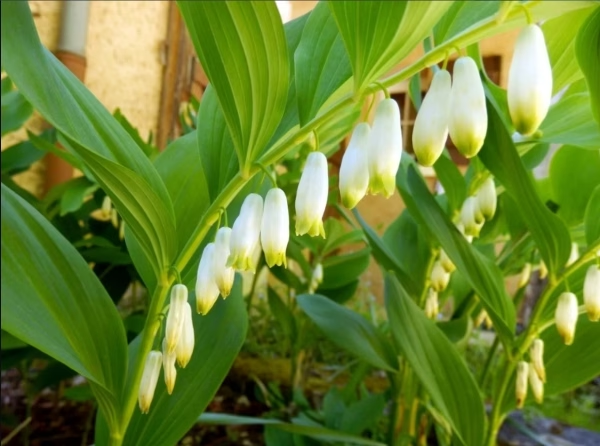
Solomon’s Seal
Botanical Name
:
Polygonatum spp.
Plant Type
:
Herbaceous perennial
Seasons
:
Plant in spring or fall; blooms in late spring to early summer
Sun Level
:
Partial shade to full sun (at least 6 hours of sunlight)
Ideal Soil Temperature for Planting
:
41 to 89.6 °F (5 to 32 ℃)
Soil Type
:
Moist, well-drained, humus-rich soil
Hardiness Zones
:
3–9 (USDA)
Germination
:
Can be slow and erratic from seed (takes up to one year). More commonly propagated by division
P.H. Level
:
5.5–7.0 (slightly acidic to neutral)
Water/Irrigation
:
Keep soil consistently moist, especially during dry periods. Avoid soggy soil
Fertilization
:
Not typically required in rich soils. A light application of balanced fertilizer in spring can be beneficial in poor soils
Habit
:
Arching stems with alternately arranged leaves, spreading by rhizomes to form colonies.
Propagation
:
Division (in spring or fall), seed (but can be slow)
Final Plant Height
:
1–3 ft
Spread
:
1–2 ft
Flowers
:
Small, bell-shaped, white or greenish-white flowers that hang down from the stem in pairs or clusters
Attracts
:
Bees, hummingbirds
Uses
:
Ground cover in shade gardens, woodland gardens, naturalized areas
Companions
:
Hostas, ferns, astilbe, bleeding heart (Dicentra), other shade-loving plants
Pruning
:
Remove any dead or damaged foliage in late winter or early spring
Toxicity
:
Generally considered non-toxic, but as with any plant, it’s best to avoid consuming large quantities
Pests
:
Slugs, snails
Diseases
:
Powdery mildew, and leaf spots
Fun Fact
:
The common name “Solomon’s Seal” comes from the markings on the rhizome, which resemble the seal of King Solomon
Additional Info
:
Native to eastern North America. The name “Polygonatum” comes from the Greek words “poly” (many) and “gonu” (knee), referring to the jointed rhizomes
Botanical Name
:
Polygonatum spp.
Plant Type
:
Herbaceous perennial
Seasons
:
Plant in spring or fall; blooms in late spring to early summer
Sun Level
:
Partial shade to full sun (at least 6 hours of sunlight)
Ideal Soil Temperature for Planting
:
41 to 89.6 °F (5 to 32 ℃)
Soil Type
:
Moist, well-drained, humus-rich soil
Hardiness Zones
:
3–9 (USDA)
Germination
:
Can be slow and erratic from seed (takes up to one year). More commonly propagated by division
P.H. Level
:
5.5–7.0 (slightly acidic to neutral)
Water/Irrigation
:
Keep soil consistently moist, especially during dry periods. Avoid soggy soil
Fertilization
:
Not typically required in rich soils. A light application of balanced fertilizer in spring can be beneficial in poor soils
Habit
:
Arching stems with alternately arranged leaves, spreading by rhizomes to form colonies.
Propagation
:
Division (in spring or fall), seed (but can be slow)
Final Plant Height
:
1–3 ft
Spread
:
1–2 ft
Flowers
:
Small, bell-shaped, white or greenish-white flowers that hang down from the stem in pairs or clusters
Attracts
:
Bees, hummingbirds
Uses
:
Ground cover in shade gardens, woodland gardens, naturalized areas
Companions
:
Hostas, ferns, astilbe, bleeding heart (Dicentra), other shade-loving plants
Pruning
:
Remove any dead or damaged foliage in late winter or early spring
Toxicity
:
Generally considered non-toxic, but as with any plant, it’s best to avoid consuming large quantities
Pests
:
Slugs, snails
Diseases
:
Powdery mildew, and leaf spots
Fun Fact
:
The common name “Solomon’s Seal” comes from the markings on the rhizome, which resemble the seal of King Solomon
Additional Info
:
Native to eastern North America. The name “Polygonatum” comes from the Greek words “poly” (many) and “gonu” (knee), referring to the jointed rhizomes
Written by Nondiah Khalayi – https://www.linkedin.com/in/nondiah-khalayi/

